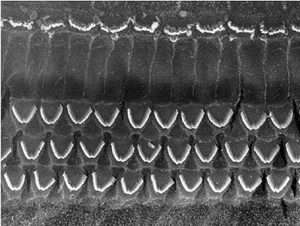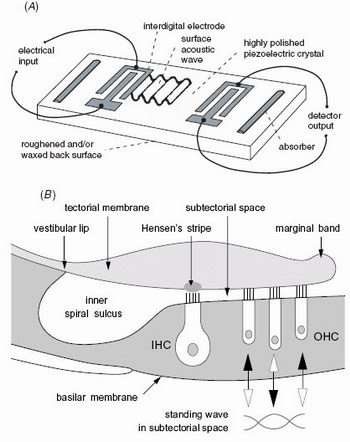January 9, 2007 feature
Analogy of cochlea as resonator could lead to artificial copies

In attempting to construct an artificial cochlea—and faced with limited knowledge of how the living chamber works—scientists might need to look no further than a simple electronic device: a surface acoustic wave (SAW) resonator. Recently, scientist Andrew Bell suggested that the cochlea exhibits similar structure and electromechanical properties to this common piece of circuitry.
The cochlea—a spiral-shaped, hollow bone in the inner ear—plays a vital role in sensing, processing, and amplifying sounds. The common understanding of the workings of the cochlea centers on its passive behavior, in which tiny hair cells create electrical signals from vibrations in the surrounding fluid.

In developing his new idea, Bell was inspired by a discovery in 1978 that most human ears continuously emit very pure, soft tones—sounds which can be picked up with a sensitive microphone. The current theory of a hydrodynamical traveling wave stimulating hair cell stereocilia does not easily accommodate such fine tuning, leading Bell to propose that the outer hair cells in the cochlea actively cooperate to amplify sound.
“When you listen to a recording of the sound that the cochlea makes, you hear something like a carillon of wind chimes,” Bell told PhysOrg.com. “It's easy to get the impression that something seems to be resonating.”
He considered a design where the cochlea would function like a SAW resonator, a device in solid-state electronics commonly used in cell phones due to its small size. SAW resonators use rows of electrodes to process signals by creating electromechanical waves between them whose wavelengths correspond to the spacing of the electrodes.
Bell noted a striking characteristic of the outer hair cells: they always lie in three well-defined rows, much like the electrodes on a SAW resonator. Bell thinks that the waves align with the rows of hair cells, with the first and third rows being in antiphase with the middle row. Such SAW-like behavior would also correspond well with results from past experiments in auditory science.
Further, like a SAW resonator, the cochlear amplifier would operate in a feedback circuit mediated by the waves. Because the hair cells are linked to soft structures such as the gelatinous tectorial membrane, feedback in the cochlea would require a slow-moving wave, one with a very short wavelength. Recently, a prime candidate for such a wave has been identified: called “squirting waves,” these waves arise in fluids constrained in ways similar to those found in the cochlea.
Using squirting waves and the SAW configuration, the cochlea could theoretically provide sharp resonance frequencies typical of the human ear, in the range of 20 to 20,000 Hz.
“The idea is that cells are not lonely, independent entities unaware of other cells,” said Bell. “Instead, cells appear in populations and cooperatively interact so as to perform signal processing. We have long known that nerve cells process information via a network of interactions (neural nets), but here we see a preneural example: outer hair cells act both to detect sound and pass it on to neighboring cells, which do the same. Shuttling of signals back and forth leads to positive feedback and frequency analysis, and this might prompt us to look for similar interactions among other sensing cells. Visual, olfactory, and balance cells, for example, could well work in similar ways.”
Bell speculates that the main reason past artificial cochleas fell short is that their designers focused on the passive traveling wave picture. But building a cochlea based on the active processes residing in the resonator analogy may, Bell thinks, open up a much more effective way forward.
“A SAW-like cochlea would form a rugged spectral analyzer—a reasoning behind existing artificial cochleas—but it could be much more sensitive then existing prototypes,” said Bell.
Bell explained that more experiments and testing will determine if this idea is accurate. He also added that there may be some exciting characteristics of the ear to discover.
“Future research needs to be directed to validating the SAW resonator model,” he said. “But then there are finer features which call for explanation, too. What is the purpose of the 'V' shape of the stereocilia, for example? There is reason to think it could relate to detecting musical ratios in sounds, and if so this would give a marvelous physical underpinning to our remarkable musical sense. The cochlea may be highly tuned—and musical.”
Citation: Bell, Andrew. “Sensors, motors, and tuning in the cochlea: interacting cells could form a surface acoustic wave resonator.” Bioinspiration and Biomimetics 1 (2006) 96-101.
By Lisa Zyga, Copyright 2006 PhysOrg.com.
All rights reserved. This material may not be published, broadcast, rewritten or redistributed in whole or part without the express written permission of PhysOrg.com.




















